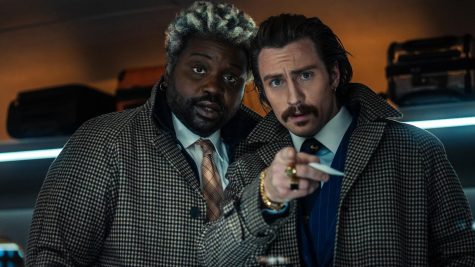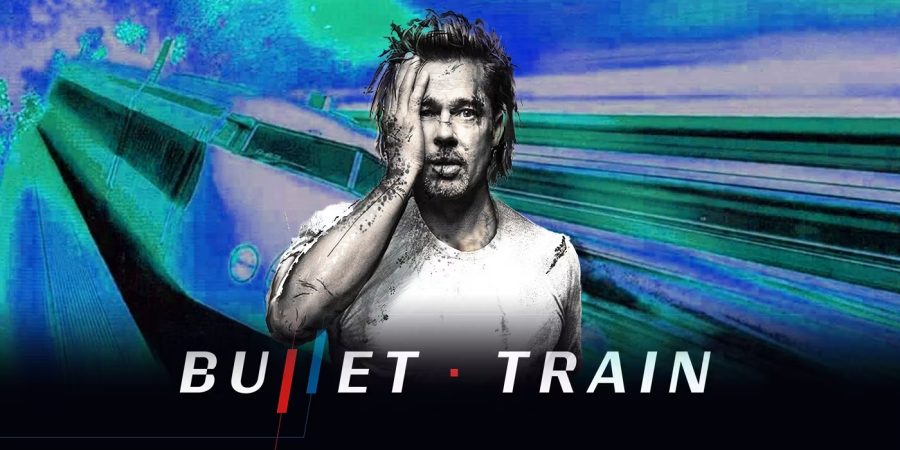Bullet Train: Off the Rail Innovation In Movie-Making
Breaking down Bullet Train’s breakneck camerawork and unique setting
“Everything that has ever happened to you has led you here,” says the cliche, wise old man to Ladybug (Brad Pitt) as he prepares to fight the head of the Yakuza on the world’s fastest train.
Directed by David Leitch, Bullet Train takes place on a Shinkansen whizzing through Japan, carrying a ludicrous number of trigger-happy assassins—all ready to throw down the gauntlet. The labyrinthine story follows Ladybug as he attempts to complete his (what should be simple) mission, narrowly missing death by a hair.
Whether it be an assassin disguised in a Momomon costume, a killer with daddy issues, or an assassin with a moral complex molded by Thomas the Tank Engine, Bullet Train fully cultivates and embraces ingenuity in its film-making process.

Incorporating LED panels, CGI, color psychology, and subversive camera angles, Bullet Train’s breakneck cinematography promotes the originality and comedic style the movie is characterized by. The movie was shot in both Los Angeles and Tokyo; however, the actual train scenes were simulated through LED panels placed on both sides of a train set.
In fact, the producers filmed the entire trip from Tokyo to Kyoto, so scenes could have multiple angles and perspectives. These eccentric camera angles paired with quickly-sliding shots panning from protagonist to opponent adds a comedic, animated feel to the movie, hardwiring its whimsical nature into the cinematographic experience.
Moreover, the bluntness of the camerawork adds a distinctly human touch, including many closeup shots which make the characters more transparent, emotional, and real. Ultimately, the inventive cinematography of LED panels and camerawork contribute to one of the most visually creative movies that exist to this day.
A counter-cultural factor that this movie integrates is its utilization of a singular setting: a Japanese bullet train. About 90% of the movie features scenes on the same train, yet it never once gets dull. In fact, the film takes advantage of all the space; through cozy luggage compartments, a generous load of bathrooms, and even the top of the train.
Even as the same cabins are frequently revisited, somehow a whole new experience is created by the different moods surrounding the characters’ circumstances; a fight scene could instantly shift to a sentimental one, then to a lighthearted one, all within the same cabin. So many emotions are felt in the same space, yet each separate compartment of the train still manages to have its own unique personality and story. With all these different aspects taken into consideration, Bullet Train successfully transforms a familiar setting into an erratic rollercoaster filled with unexpected detours.

Aside from its obvious all-star cast, the actual acting in Bullet Train truly is a work of art. The way the characters interact with one another in their own unique way paired with the actors’ embodiment of their characters’ definitive traits is something that simply cannot be replicated.
Watching the movie for the first time makes you truly feel for the characters, unlocking a whole new set of emotions. Dynamics between the characters brought the plot to life; with every interaction, the tension or connection between characters allowed the storyline to progress.
Most notably, the brotherly relationship between the characters Tangerine (Aaron Taylor-Johnson) and Lemon (Brian Tyree Henry) will constantly have you doubled over the edge of your seat! Despite Bullet Train being—what some might call—a gruesome movie, its use of comedy to “lighten the mood” really makes the movie original.
Every single one of Bullet Train’s action-packed scenes draws you in, and time and time again, exceeds your expectations. Bullet Train successfully walks the tightrope between comedy and action by means of innovative cinematography and unique storytelling. And some advice from Lemon: “Sometimes you’ve gotta shoot first and come up with answers later.”


